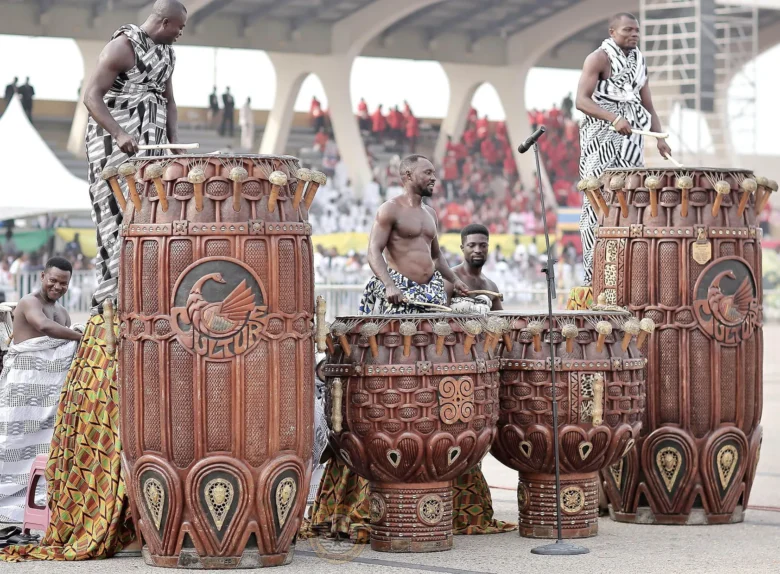Ghanaian drumming and dance are more than performance—they are powerful expressions of culture, identity, and history. For visitors, experiencing these traditions firsthand offers a window into the heart of Ghana’s vibrant communities, where rhythm and movement are integral to everyday life.
Whether you’re watching a royal durbar in Kumasi, taking part in a beach drum circle in Accra, or attending a village festival in the Volta Region, this guide will help you understand the significance, styles, and how you can respectfully engage with Ghanaian drumming and dance.
The Cultural Significance of Drumming and Dance in Ghana
Drumming and dance in Ghana are deeply rooted in community life. They serve a wide range of purposes:
- Communication: Talking drums historically conveyed messages between villages.
- Celebration: Used at festivals, weddings, and naming ceremonies.
- Ritual: Central to religious events and rites of passage.
- Storytelling: Movements and rhythms narrate historical events or moral lessons.
- Social Cohesion: Brings communities together and reinforces identity.
Most Ghanaian ethnic groups have their own unique drumming and dance traditions, passed down through generations and often tied to specific social roles or historical moments.
Key Ethnic Traditions and Styles
1. Ashanti (Asante) – Royal Elegance and Symbolism
- Popular Dances: Adowa, Kete, Fontomfrom
- Features:
- Danced during funerals, festivals, and palace ceremonies
- Symbolic hand and body gestures representing emotions
- Often performed by women in colorful kente cloth
- Instruments:
- Fontomfrom drums: Large drums used to announce royalty
- Atumpan (talking drums): Used to mimic speech and proverbs
2. Ewe – Complex Polyrhythms
- Popular Dances: Agbadza, Gahu, Atsiagbekor
- Features:
- Intricate footwork with responsive call-and-response movements
- Traditionally performed during war, harvest, or social gatherings
- Agbadza is one of the most accessible and popular Ewe dances
- Instruments:
- Atsimevu (lead drum), Sogo, Kidi, Kagan, and Gankogui (bell)
3. Ga-Dangme – Coastal Celebration
- Popular Dances: Kpanlogo
- Features:
- Youth-centered dance that emerged in the 1960s
- Emphasizes pelvic movements and upper body rhythm
- Very popular in Accra and often seen during beach drumming sessions
- Instruments:
- Kpanlogo drums (conga-like), shakers, bells
4. Dagomba (Northern Ghana) – Praise and Storytelling
- Popular Dances: Takai, Simpa
- Features:
- Men use swords or sticks in synchronized moves
- Traditional dances used to honor chiefs or spiritual leaders
- Instruments:
- Lunga (talking drum), gungon, and flutes
Where to See Drumming and Dance in Ghana
| Location | Experience Type | Best For |
|---|---|---|
| W.E.B. DuBois Centre, Accra | Weekly cultural performances | Casual introduction |
| Kokrobite (near Accra) | Beach drum circles & workshops | Interactive, relaxed learning |
| National Theatre, Accra | Formal shows by the National Dance Company | Professional performances |
| Cape Coast Festivals | Cultural processions, funerals | Authentic community displays |
| Kumasi (Akwasidae Festival) | Royal dances and drum parades | Regal Ashanti traditions |
| Dagbon (Northern Region) | Local festivals, chieftaincy events | Spiritual and historical depth |
How to Participate as a Visitor
You don’t need to be an expert to take part in Ghanaian drumming or dance. Most communities are welcoming, and many institutions offer short experiences tailored for travelers.
Take a Drumming or Dance Workshop
- Where: Kokrobite, Cape Coast, Tamale, or cultural centers in Accra
- Duration: Ranges from 1 hour to multi-day immersion
- What You’ll Learn:
- Basic hand techniques for traditional drums
- Introduction to rhythm patterns and polyrhythms
- Movements tied to specific ethnic dances
Join a Community Performance
- During festivals, you may be invited to join in the dance circle. Follow these etiquette tips:
- Wait to be invited or encouraged.
- Watch and imitate simple movements.
- Show respect—avoid mocking or exaggerated gestures.
Buy Instruments and Support Local Artists
If you enjoy the experience, consider purchasing a locally made drum like a djembe or kpanlogo. Make sure to buy from artisans or cooperatives to support fair trade.
Instruments Overview: What You’ll Hear
| Instrument | Description | Common Uses |
|---|---|---|
| Djembe | Rope-tuned hand drum (not native, but popular) | General performance, fusion styles |
| Kpanlogo Drum | Medium-size drum with open bottom | Kpanlogo dance, youth music |
| Talking Drum | Hourglass-shaped, pitch-modifiable | Royalty, announcements, praise |
| Atumpan | Twin barrel drums, large and bassy | Ashanti and Akan ceremonies |
| Gankogui Bell | Iron bell, timekeeper in ensembles | All traditional ensembles |
| Shekere | Gourd rattle with beads | Dance accompaniment |
Major Festivals Featuring Traditional Music and Dance
Homowo Festival (Accra)
- Celebrated by the Ga people
- Features kpanlogo drumming, food sharing, and traditional rites
Aboakyir Festival (Winneba)
- Hunting-themed festival with dramatic dance performances
Akwasidae Festival (Kumasi)
- Held every six weeks by the Ashanti Kingdom
- Includes regal drumming and palace processions
Damba Festival (Northern Ghana)
- Combines Islamic customs with Dagomba cultural dance and music
You can find a national festival calendar via the Ghana Tourism Authority.
Etiquette and Respectful Engagement
- Ask before filming or photographing performers, especially at sacred or spiritual events.
- Dress modestly when attending traditional ceremonies.
- Observe before participating, especially during rituals or funerals.
- Support local performers by tipping, buying crafts, or booking paid experiences.
Final Thoughts
Ghanaian drumming and dance aren’t just performances—they are living traditions that communicate stories, preserve identity, and bring people together. For visitors, engaging with these vibrant art forms adds depth and meaning to your journey through Ghana.
Whether you’re clapping along to a village drum circle or taking your first steps in an Adowa workshop, the rhythm of Ghana will stay with you long after your visit ends.




